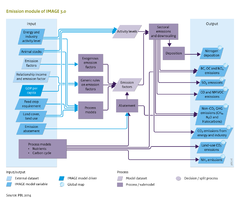Emissions/Description: Difference between revisions
Jump to navigation
Jump to search
Oostenrijr (talk | contribs) No edit summary |
No edit summary |
||
| Line 1: | Line 1: | ||
{{ComponentDescriptionTemplate | {{ComponentDescriptionTemplate | ||
|Reference=IPCC, 2006; Cofala et al., 2002; Stern, 2003; Smith et al., 2005; Van Ruijven et al., 2008; Carson, 2010; Smith et al., 2011; Bouwman et al., 1993; Velders et al., 2009; Kreileman and Bouwman, 1994; Bouwman et al., 1997; Bouwman et al., 2002a; Velders et al., 2009; Harnisch et al., 2009; | |Reference=IPCC, 2006; Cofala et al., 2002; Stern, 2003; Smith et al., 2005; Van Ruijven et al., 2008; Carson, 2010; Smith et al., 2011; Bouwman et al., 1993; Velders et al., 2009; Kreileman and Bouwman, 1994; Bouwman et al., 1997; Bouwman et al., 2002a; Velders et al., 2009; Harnisch et al., 2009; Braspenning Radu et al., 2016; | ||
|Description====General approaches=== | |Description====General approaches=== | ||
Air pollution emission sources included in IMAGE are listed in [[Emission table]], and emissions transported in water (nitrate, phosphorus) are discussed in Component [[Nutrients]]. In approach and spatial detail, gaseous emissions are represented in IMAGE in four ways: | Air pollution emission sources included in IMAGE are listed in [[Emission table]], and emissions transported in water (nitrate, phosphorus) are discussed in Component [[Nutrients]]. In approach and spatial detail, gaseous emissions are represented in IMAGE in four ways: | ||
| Line 37: | Line 37: | ||
Emission factors ([[#General approaches|Equation 1]]) are used for estimating emissions from the energy-related sources ([[Emission table]]). In general, the Tier 1 approach from IPCC guidelines ([[IPCC, 2006]]) is used. In the energy system, emissions are calculated by multiplying energy use fluxes by time-dependent emission factors. Changes in emission factors represent, for example, technology improvements and end-of-pipe control techniques, fuel emission standards for transport, and clean-coal technologies in industry. | Emission factors ([[#General approaches|Equation 1]]) are used for estimating emissions from the energy-related sources ([[Emission table]]). In general, the Tier 1 approach from IPCC guidelines ([[IPCC, 2006]]) is used. In the energy system, emissions are calculated by multiplying energy use fluxes by time-dependent emission factors. Changes in emission factors represent, for example, technology improvements and end-of-pipe control techniques, fuel emission standards for transport, and clean-coal technologies in industry. | ||
The emission factors for the historical period for the energy system and industrial processes are calibrated with the EDGAR emission model described by Braspenning Radu et al. ([[Braspenning Radu et al., | <div class=“version changev31”> | ||
The emission factors for the historical period for the energy system and industrial processes are calibrated with the EDGAR emission model described by Braspenning Radu et al. ([[Braspenning Radu et al., 2016]]). Calibration to the EDGAR database is not always straightforward because of differences in aggregation level. The general rule is to use weighted average emission factors for aggregation. However, where this results in incomprehensible emission factors (in particular, large differences between the emission factors for the underlying technologies), specific emission factors were chosen. | |||
</div> | |||
Future emission factors are based on the following rules: | Future emission factors are based on the following rules: | ||
Revision as of 21:39, 6 November 2016
Parts of Emissions/Description
| Component is implemented in: |
Components:and
|
| Projects/Applications |
| Models/Databases |
| Key publications |
| References |
|
